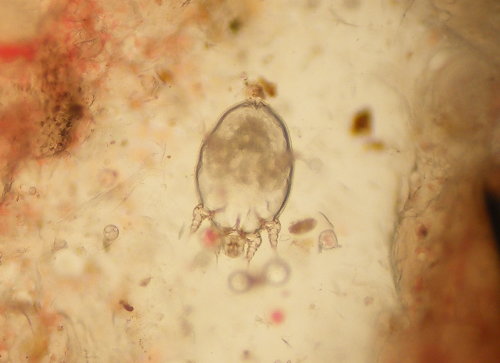Difference between revisions of "Clinical Case 4 - Page 4"
Jump to navigation
Jump to search
| (7 intermediate revisions by 2 users not shown) | |||
| Line 8: | Line 8: | ||
What is this? | What is this? | ||
| − | *<font color="white"> This is a mite. It has short, stumpy legs, making it a burrowing mite. This is ''Sarcoptes scabiei'' var canis, the sarcoptic mange mite of dogs. </font> | + | *<font color="white"> This is a mite. It has short, stumpy legs, making it a burrowing mite. This is ''Sarcoptes scabiei'' var canis, the sarcoptic mange mite of dogs. IMPORTANT: sarcoptic mange mites are not easy to find. Even a good skin scrape may only yield a single mite (or none at all). Therefore it is important to scan the ENTIRE slide for mites. Usually they are still moving, making them a little easier to spot. Sometimes all that can be found is an egg and, if you can identify it as such, this is enough to make a diagnosis. The author uses the x10 objective to scan slides for sarcoptic mange mites. As you can see from the previous picture, they can be easy to miss under the x4. </font> |
Can this condition affect the owner? | Can this condition affect the owner? | ||
| − | *<font color="white"> Yes. WARN THE OWNER THAT THIS IS A ZOONOTIC DISEASE. ''Sarcoptes scabiei'' is host adapted and is therefore unlikely to flourish on a human host, but it is still capable of causing an irritating rash. This is most commonly found on the hands and arms of the owner, where they come into contact with the dog. In humans, the lesions sometimes take on the appearance of raised tunnels. | + | *<font color="white"> Yes. WARN THE OWNER THAT THIS IS A ZOONOTIC DISEASE. ''Sarcoptes scabiei'' is host adapted and is therefore unlikely to flourish on a human host, but it is still capable of causing an irritating rash. This is most commonly found on the hands and arms of the owner, where they come into contact with the dog. In humans, the lesions sometimes take on the appearance of raised tunnels. Immunocompromised people can develop a very severe form of the disease with extensive crusting, known as Norwegian scabies. This is useful to know to help with diagnosis of the animal's condition but do not be tempted to treat the owner! A vet should never advise the owner on this, except to see their GP.</font> |
How is this condition treated? | How is this condition treated? | ||
| Line 19: | Line 19: | ||
*<font color="white"> Treat the other dog.</font> | *<font color="white"> Treat the other dog.</font> | ||
| + | Why do you think there is a soft, fluctuant swelling on Molly's ear? How is this treated? | ||
| + | *<font color="white"> This is an aural haematoma and is most often seen in conjunction with ear disease. In this case it may be related to trauma as a result of head shaking and scratching. Aural haematomas are best treated surgically.</font> | ||
| − | <big><center>[[ | + | |
| + | |||
| + | To find out more you can use the link [[CCSA4|HERE]]. | ||
| + | |||
| + | |||
| + | <big><center>[[Cases from General Practice - Small Animal|'''BACK TO CASES FROM GENERAL PRACTICE - SMALL ANIMAL''']]</center></big> | ||
| + | |||
| + | |||
| + | [[Category:Lost]] | ||
Latest revision as of 16:58, 24 February 2011
Courtesy of C. Antonczyk
This image is as viewed under the x10 objective.
What is this?
- This is a mite. It has short, stumpy legs, making it a burrowing mite. This is Sarcoptes scabiei var canis, the sarcoptic mange mite of dogs. IMPORTANT: sarcoptic mange mites are not easy to find. Even a good skin scrape may only yield a single mite (or none at all). Therefore it is important to scan the ENTIRE slide for mites. Usually they are still moving, making them a little easier to spot. Sometimes all that can be found is an egg and, if you can identify it as such, this is enough to make a diagnosis. The author uses the x10 objective to scan slides for sarcoptic mange mites. As you can see from the previous picture, they can be easy to miss under the x4.
Can this condition affect the owner?
- Yes. WARN THE OWNER THAT THIS IS A ZOONOTIC DISEASE. Sarcoptes scabiei is host adapted and is therefore unlikely to flourish on a human host, but it is still capable of causing an irritating rash. This is most commonly found on the hands and arms of the owner, where they come into contact with the dog. In humans, the lesions sometimes take on the appearance of raised tunnels. Immunocompromised people can develop a very severe form of the disease with extensive crusting, known as Norwegian scabies. This is useful to know to help with diagnosis of the animal's condition but do not be tempted to treat the owner! A vet should never advise the owner on this, except to see their GP.
How is this condition treated?
- Molly was treated with two appliations of selamectin, one month apart.
What else should you advise the owner to do?
- Treat the other dog.
Why do you think there is a soft, fluctuant swelling on Molly's ear? How is this treated?
- This is an aural haematoma and is most often seen in conjunction with ear disease. In this case it may be related to trauma as a result of head shaking and scratching. Aural haematomas are best treated surgically.
To find out more you can use the link HERE.
